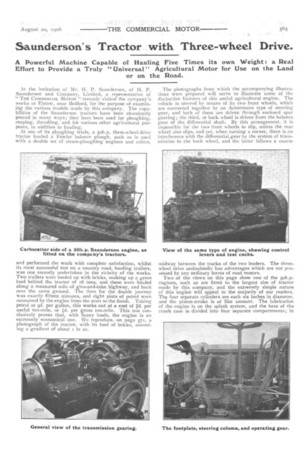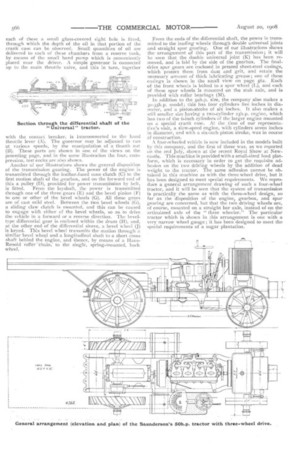Saunderson' s Tractor with Three-wheel Drive.
Page 5

Page 6

If you've noticed an error in this article please click here to report it so we can fix it.
A Powerful Machine Capable of Hauling Five Times its own Weight : a Real Effort to Provide a Truly "Universal" Agricultural Motor for Use on the Land or on the Road.
At the invitation of Mr. H. P. Saunderson, of H. P. Saunderson and Company, Limited, a representative of "1'n COMMERCIAL Moiort " recently visited the company's works at Elstow, near Bedford, for the purpose of examining the various models made by this company. The capabilities of the Saunderson tractors have been abundantly proved in many ways; they have been used for ploughing, reaping, threshing-, and for various other agricultural purposes, in addition to hauling.
At one of its ploughing trials, a sob.p. three-wheel-drive tractor hauled a Fowler balance plough, such as is used with a double set of stearn-ploughing engines and cables,
and performed the work with complete satisfaction, whilst its most successful test on a country road, hauling trailers, was one recently undertaken in the vicinity of the works. Two trailers were loaded up with bricks, making up a gross load behind the tractor of 18 tons, and these were hauled along a measured mile of give-and-take highway, and back over the same ground. The time for the double journey was exactly fifteen minutes, and eight pints of petrol were consumed by the engine from the start to the finish. Taking petrol at gd. per gallon, this works out at a cost of ad. per useful ton-mile, or id, per gross ton-mile. This test conclusively proves that, with heavy loads, the engine is an extremely economical one. We reproduce, on page 571, a photograph of the tractor, with its load of bricks, ascending a gradient of about i in 20.
The photographs from which the accompanying illustrations were prepared will serve to illustrate some of the distinctive features of this useful agricultural engine. The vehicle is steered by means of its two front wheels, which are connected together by an Ackermann type of steering gear, and both of them are driven through enclosed spur gearing ; the third, or back wheel is driven from the balance gear of the differential shaft. By this arrangement, it is impossible for the two front wheels to slip, unless the rear wheel also slips, and yet, when turning a corner, there is no interference with the differential gear by the system of transmission to the back wheel, and the latter follows a course midway between the tracks of the two leaders. The threewheel drive undoubtedly has advantages which are not possessed by any ordinary forms of road motors.
Two of the views on this page show one of the soh.p. engines, such as are fitted to the largest size of tractor made by this company, and the extremely simple nature of this engine will appeal to the majority of our readers. The four separate cylinders are each six inches in diameter, and the piston-stroke is of like amount. The lubrication of the engine is on the splash system, and the base of the crank case is divided into four separate compartments; in
each of these a small glass-covered sight hole is fitted, through which the depth of the oil in that portion of the crank case can be observed. Small quantities of oil are delivered to eaeh of these chambers from a reserve tank, by means of the small hand pump which is conveniently placed near the driver. A simple governor is connected up to the main throttle valve, and this in turn, together with the contact breaker, is interconnected to the hand throttle lever (A). The governor may be adjusted to run at various speeds, by the manipulation of a thumb nut (B). These parts are shown in one of the views on the preceding page, and in the same illustration the four, compression, test cocks are also shown. Another of our illustrations shows the general disposition of the transmission gearing. The power of the engine is transmitted through the leather-faced cone clutch (C) to the first motion shaft of the gearbox, and on the forward end of this a pulley (D), provided for power transmission by belt, is fitted. From the layshaft, the power is transmitted through one of the three gears (E) and the bevel pinion (F) to one or other of the bevel wheels (G). All these gears are of cast mild steel. .Between the two bevel wheels (G), a sliding claw clutch is mounted, and this can be caused to engage with either of the bevel wheels, so as to drive the vehicle in a forward or a reverse direction. The beveltype differential gear is enclosed within the drum (H), and, at the other end of the differential sleeve, a bevel wheel (J) is keyed. This bevel wheel transmits the motion through a similar bevel wheel and a longitudinal shaft to a short cross shaft behind the engine, and thence, by means of a HansRenold 'tolle-r-Chain,to the single, spring-mounted, back wheel. From the ends of the differential shaft, the power is transmitted to the leading wheels through double universal joints and straight spur gearing. One of our illustrations shows the -arrangement of this part of the transmission; it will be seen that the double universal joint (K) has been removed, and is laid by the side of the gearbox. The finaldrive spur gears are enclosed in pressed sheet-steel casings, which protect them from dust and grit, and retain the necessary amount of thick lubricating grease ; one of these casings is shown in the small view on page 562. Each of the front wheels is bolted to a spur wheel (E.), and each of these spur wheels is mounted on the stub axle, and is provided with roller bearings (M). In addition to the ,soh.p. size, the company also makes a 3o-35h.p. model; this has four cylinders five inches in diameter, and a piston-stroke of six inches. It also makes a still smaller size having a two-cylinder 2511.p. engine, which has two of the 6-inch cylinders of the larger engine mounted on a special crank case. At the Lime of our representative's visit, a slow-speed engine, with cylinders seven inches in diameter, and with a six-inch piston stroke, was in course. of construction. A four-wheeled vehicle is now included in the models built by this company, and the first of these was, as we reported on the znd July, shown at the recent Royal Show at Newcastle. This machine is provided with a small-sized load platform, which is necessary in order to get the requisite adhesion on the two driving wheels by the addition of dead weight to the tractor. The same adhesion cannot be obtained in this machine as with the three wheel drive, but it has been designed to meet special requirements. We reproduce a general arrangement drawing of such a four-wheel tractor, and it will he seen that the system of transmission is practically the same as with the three.wheel design, so far as the disposition of the engine, gearbox, and spur gearing are concerned, but that the two driving wheels are, of course, mounted on a straight bar axle, instead of on the articulated axle of the " three wheeler." The particular tractor which is shown in this arrangement is one with a very narrow wheel gauge; it has been designedto meet the special requirements of a sugar plantation.


















